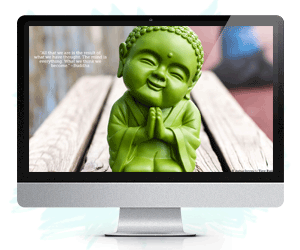
“Rest and be thankful.” ~William Wordsworth
A few years ago, I caught myself doing something that made no sense.
It was late evening, my kids were asleep, the house finally quiet. I’d been counting down to this moment all day—dreaming of sinking into the couch, wrapping myself in a blanket, maybe even reading a book without distractions.
But when I lay down and closed my eyes, something inside me lurched. Within seconds, I reached for my phone. I didn’t even have anything urgent to check—just mindless scrolling. Five minutes in, I was already half-sitting up, wondering if I should fold the laundry or answer one last email. Before I knew it, I was back on my feet, tidying up the kitchen.
I remember thinking, why can’t I just rest?
The Invisible Weight That Keeps Us Restless
Maybe you’ve felt this too. You plan a quiet evening—maybe a bath, a book, or just lying down in silence—but your mind buzzes with things you should be doing instead.
Did I reply to that message? Should I wipe down the counters? Maybe I should check my notifications—just in case.
It’s so easy to blame ourselves: I have no discipline. I’m addicted to my phone. I can’t sit still. But the truth is, our difficulty with rest runs deeper than bad habits or busy schedules.
Sometimes our bodies and minds have learned that stillness isn’t safe.
Why Does Rest Feel So Uncomfortable?
I used to think I was just bad at relaxing—like I’d missed a class everyone else had taken. But over time, I realized there were reasons why lying still felt so wrong.
Here’s what I’ve learned—and maybe you’ll see yourself here too.
1. We equate stillness with danger.
Deep down, part of our nervous system still believes we’re in the wild—where lying still too long could make us vulnerable. Even if our physical world is safe, our inner world might not feel that way.
Many of us grew up in homes where we had to stay alert—watching moods, avoiding conflict, keeping busy to feel useful or unnoticed. Being on guard felt safer than relaxing.
Even now, when the house is calm, our bodies may still whisper: Don’t settle. Something could happen.
2. We tie our worth to doing.
Growing up, I learned that being “good” meant being helpful—doing the dishes before being asked, getting top grades, staying busy. Rest wasn’t modeled as something normal; it was a luxury you earned only after everything was done perfectly.
So when I lie down on the couch, an old voice pipes up: Have you really done enough to deserve this? Even now, I still catch myself folding laundry at 10 p.m. or working on my blog instead of just letting myself rest.
3. Rest brings up uncomfortable feelings.
Stillness creates space. And sometimes, that space fills with things we’d rather keep buried—worries we ignored all day, sadness we don’t want to name, thoughts that make us feel alone.
So instead of resting, we keep busy. We scroll, clean, or half-watch TV while half-doing chores. Movement feels safer than meeting whatever rises in the quiet.
4. Our brains crave the next hit.
Our world feeds this cycle. Apps, notifications, endless news—tiny dopamine bursts that keep our minds buzzing. Even when we’re exhausted, our brains crave just one more swipe, one more update.
So when we try to rest, it feels like a mini withdrawal. The silence can feel almost unbearable.
The Good News: Rest Is a Skill We Can Relearn
If you see yourself in any of this, you’re not broken. There’s nothing wrong with you. Rest just feels unfamiliar because your body and mind learned to survive without it.
The good news is you can gently retrain yourself to feel safe doing nothing. Not by forcing it—but by meeting your restlessness with small, doable shifts.
Small Ways to Make Rest Feel Safe Again
1. Start tiny.
I used to think rest meant lying still for an hour—meditating, deep breathing, total quiet. That was way too much.
Instead, try building up your tolerance for stillness in small ways:
Sit for ten slow breaths before grabbing your phone in the morning.
Pause for a few seconds before switching tasks.
Lie down for two minutes with your eyes closed before bed.
I started with just a few slow breaths while breastfeeding. It helped both me and my baby settle a bit more.
Tiny moments teach your body: Stillness doesn’t have to be scary.
2. Notice the thoughts that rush in.
Sometimes when we try to rest, thoughts pop up:
You’re wasting time.
You should be doing something useful.
Just one more thing, then you can relax.
When you notice these thoughts, name them. Gently remind yourself: Rest is useful. Doing nothing is not the same as being nothing.
3. Give your body a gentle cue.
Rest doesn’t have to mean lying statue-still. If stillness feels like too much, try calming your nervous system with small, soothing actions:
Sip warm tea and notice its warmth. I love slowly brewing tea and taking a moment just to smell it before I drink.
Wrap yourself in a blanket and sway gently.
Sit in a rocking chair. Rocking can feel safer than stillness.
4. Turn rest into a ritual.
It helps to make rest intentional—a small, predictable act of care.
Maybe you light a candle when you sit down. Or play soft music. Or put away your phone and focus on the warmth of a bath.
A ritual makes rest feel like a gift, not wasted time.
5. Let discomfort be there.
Sometimes when we rest, feelings surface—sadness, guilt, unease.
Instead of pushing them away, practice sitting with them for a few breaths.
Try telling yourself, “I feel restless. That’s okay. I don’t have to fix it right now.”
Like any feeling, it passes more easily when you stop fighting it.
What Rest Really Means
When I look back, I see that my struggle with rest wasn’t really about laziness or distraction. It was about trust.
Learning to rest means trusting that the world won’t fall apart if we stop. Trusting that we’re worthy, even when we’re not “useful.” Trusting that what rises in the quiet won’t destroy us.
It’s not easy work—but it’s gentle work. And every tiny moment you spend just being—without doing, fixing, or producing—teaches your body a new truth: You are allowed to rest.
—
If you find yourself mindlessly reaching for your phone when you planned to do nothing, pause. Take one deep breath. Feel the weight of your body on the couch. Remind yourself: It’s safe to pause.
Rest is not the opposite of living. Rest is what lets us show up fully for life.
About Mina Todorova
Mina writes about healing, nervous system regulation, and personal growth on her blog fromcentowholeness.com. Most posts include simple, supportive free guides to help you apply the insights. Explore topics like emotional healing, mindful living, gentle parenting, and seasonal self-care. To support your rest journey, download her free worksheet “Learning to Feel Safe in Stillness” here.












 Though I run this site, it is not mine. It's ours. It's not about me. It's about us. Your stories and your wisdom are just as meaningful as mine.
Though I run this site, it is not mine. It's ours. It's not about me. It's about us. Your stories and your wisdom are just as meaningful as mine. 